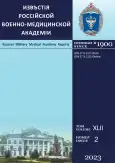The method of restoration of the second class by G.V. Black
- Authors: Gabaraeva A.S.1, Vorobyeva Y.B.1, Zheleznyak V.A.1
-
Affiliations:
- Military Medical Academy
- Issue: Vol 42, No 2 (2023)
- Pages: 149-154
- Section: Original articles
- URL: https://bakhtiniada.ru/RMMArep/article/view/316029
- DOI: https://doi.org/10.17816/rmmar397527
- ID: 316029
Cite item
Full Text
Abstract
BACKGROUND: It is known that the carious process is one of the main causes of the destruction of the integrity of the hard tissues of the tooth, especially caries of the contact surfaces of the lateral teeth, which gives the most frequent complications and is difficult to treat. The question arises of finding a new method of filling cavities of class 2 according to G.V. Black. One of the ways to improve the quality of treatment is to add a reinforcing component to the restoration.
AIM: To develop a method of restoration of extensive defects of hard tissues of teeth of the second class according to G.V. Black with additional reinforcement, to study this method in an experiment.
MATERIALS AND METHODS: The removed teeth were dissected under the cavities of the 2nd class according to G.V. Blank, the wall thickness was measured using a dental micrometer, the cavities were treated with a Single Bond Universal adhesive system, the samples were divided into 2 groups, the cavities were sealed according to the classical technique with 3M ESPE Filtek Ultimate Universal Restorative composite material and according to the developed method using a thread with composite material (dental fiber light-cured formed CATERPILLAR), after the restoration of the teeth they were subjected to metered pressure on a testing machine, a hardness tester, a trademark “Shimadzu”.
RESULTS: When conducting studies in samples of class 2 according to G.V. Black, where the tooth walls are more than 3 mm with the use of a thread with a composite, the compression force increased by 455.4 N. in comparison with the generally accepted method of filling with a composite, by 53%, respectively. In the group of class 2 according to G.V. Black, where the walls are less than 3 mm, sealed with a thread with a composite, the compression force increased by 660.21 N compared to the classical sealing technique, therefore, the quality of sealing increased by 105%.
CONCLUSION: The “Method of restoration of molars in case of significant destruction of the crown part of the tooth” has been developed (RF Patent No. 2783060). A method for restoring defects of the second class according to G.V. Black using a composite tape as a reinforcing component is proposed. During the experiment on the Shimadzu bursting machine, it was revealed that restorations performed using composite tape have better physical and mechanical properties than restorations performed exclusively with composite material.
Full Text
##article.viewOnOriginalSite##About the authors
Anna Sh. Gabaraeva
Military Medical Academy
Author for correspondence.
Email: gabaraevaan@mail.ru
ORCID iD: 0009-0002-7744-6484
SPIN-code: 8086-5263
cadet of the 5th year of the 5th faculty, member of the scientific circle of VNOKS
Russian Federation, Saint PetersburgYulia B. Vorobyeva
Military Medical Academy
Email: doctor32@bk.ru
ORCID iD: 0000-0003-0394-7868
SPIN-code: 9690-1182
M.D., Ph.D. (Medicine), Associate Professor of the General Dentistry Department
Russian Federation, Saint PetersburgVladimir A. Zheleznyak
Military Medical Academy
Email: zhva73@yandex.ru
ORCID iD: 0000-0002-6597-4450
SPIN-code: 3895-3730
M.D., D.Sc. (Medicine), Associate Professor, the Head of the General Dentistry Department
Russian Federation, Saint PetersburgReferences
- Vishnyakov NI, Danilov NO, Prozorova NV. The study of the incidence of dental caries according to the population’s appeal for dental care. Vestnik SPBGU. 2007;(4):133–142. (In Russ.)
- Iordanishvili AK, Kovalevsky AM, Balin VV, et al. Faculty Dentistry. A guide for dentists. Iordanishvili AK, Kovalevsky AM, eds. Moscow: SIMK Publ.; 2015. 504 p. (In Russ.)
- Korenevskaya NA. Post-endodontic restoration in dentistry. Teaching aid. Vitebsk: VSMU Publ.; 2018. 175 p. (In Russ.)
- Adilkhanyan VA. Osobennosti vosstanovleniya zubov posle endodonticheskogo lecheniya [dissertation]. Moscow; 2003. 101 p. (In Russ.)
- Polyanskaya LN, Bogdan GP, Makarova OV. Restoration therapy. Features of the use of modern materials for direct restoration of teeth. Educational and methodical manual. Minsk: BSMU Publ.; 2009. 48 p. (In Russ.)
- Salova AV, Rekhachev VM, Nikolaev AI, Shalomay LI. Features of preparation and restoration of cavities of class II by Black with composite materials (active and passive techniques). Institute of Dentistry. 2003;(1):97–99. (In Russ.)
- Melekhov SV. Obosnovaniye lechebno-profilakticheskikh meropriyatiy i prognoza pri razvitii oslozhneniy kariyesa zubov [dissertation]. Moscow; 1997. 26 p. (In Russ.)
- Melkonyan KG. Klinicheskaya otsenka vzaimnogo vliyaniya khronicheskogo parodontita i kariyesa kornya zuba [dissertation]. Moscow; 2004. 118 p. (In Russ.)
- Heigetyan AV. Effektivnost’ sovremennykh metodov diagnostiki i lecheniya patsiyentov s defektami tverdykh tkaney kontaktnykh poverkhnostey bokovykh zubov [dissertation]. StSMU Publ.; 2016. 198 p. (In Russ.)
- Vorobyeva YuB, Zheleznyak VA, Gabaraeva ASh. Patent No. 2783060 Russian Federation, IPC A61C5/00/ Method of restoration of molars in case of destruction of the crown part of the tooth: application 20.01.2022; publ. 08.11.2022. The applicant and the patent holder of the VMedA. 18 p. (In Russ.)
Supplementary files












